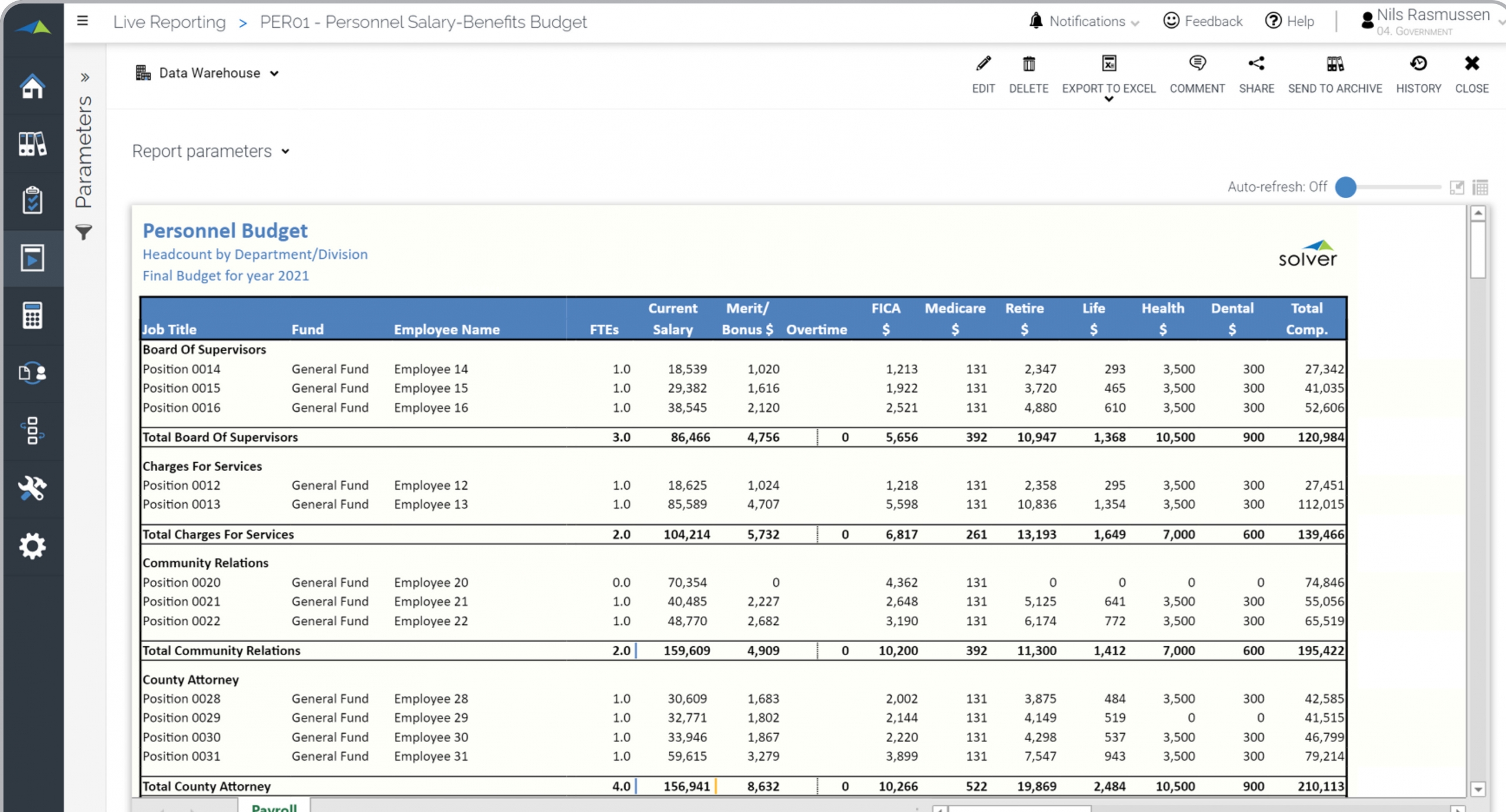Personnel Budget Report for Public Sector Organizations
What is a
Personnel Budget Report
? Employee Compensation Budget Reports are considered human capital planning analysis tools and are used by Budget Officers, HR and Financial Managers to get a clear overview of the total payroll expenses and employees included in the budget. Some of the main functionality in this type of report is that it shows all the employees, planned hires with final budget figures. It is parameter driven and the user can run it with full security for any budget version. The columns include: Job title by department, fund, employee name, FTEs, Current salary, Merit/Bonus amount, Overtime, FICA, Medicare, Retirement funding, Life insurance, Health insurance, Dental benefits, and Total compensation. You find an example of this type of report below.
Purpose of
Personnel Budget Reports with Employees and FTE details Public Sector organizations use Personnel Budget Reports to enable managers with a complete picture of the budget for employees with FTE headcount and compensation expenses by department. When used as part of good business practices in Planning, HR and Accounting departments, a government entity can improve its budget accuracy and HR planning, and it can reduce the chances that there are undetected issues or errors in the personnel budget.
Example of a
Personnel Budget Reports with Employees and FTE detail Here is an example of a Personnel Budget Report with employee metrics by person and department. [caption id="" align="alignnone" width="2560"]
 Example of a Personnel Budget Report for Public Sector Organizations[/caption] You can find hundreds of additional examples
here
Who Uses This Type of
Report
? The typical users of this type of report are: CFOs, HR managers, budget officers and department heads.
Other Reports Often Used in Conjunction with
Personnel Budget Reports Progressive Planning, HR and Accounting departments sometimes use several different Personnel Budget Reports along with employee budget input forms, capex budget models, line item detail for revenues and expenses, budget dashboards, annual budget report packages, financial dashboards, human capital dashboards and other management and control tools.
Where Does the Data for Analysis Originate From? The Actual (historical transactions) data typically comes from independent payroll systems as well as enterprise resource planning (ERP) systems like: Microsoft Dynamics 365 (D365) Finance, Microsoft Dynamics 365 Business Central (D365 BC), Microsoft Dynamics AX, Microsoft Dynamics NAV, Microsoft Dynamics GP, Microsoft Dynamics SL, Sage Intacct, Sage 100, Sage 300, Sage 500, Sage X3, SAP Business One, SAP ByDesign, Acumatica, Netsuite and others. In analyses where budgets or forecasts are used, the planning data most often originates from in-house Excel spreadsheet models or from professional corporate performance management (CPM/EPM) solutions.
What Tools are Typically used for Reporting, Planning and Dashboards? Examples of business software used with the data and ERPs mentioned above are:
Example of a Personnel Budget Report for Public Sector Organizations[/caption] You can find hundreds of additional examples
here
Who Uses This Type of
Report
? The typical users of this type of report are: CFOs, HR managers, budget officers and department heads.
Other Reports Often Used in Conjunction with
Personnel Budget Reports Progressive Planning, HR and Accounting departments sometimes use several different Personnel Budget Reports along with employee budget input forms, capex budget models, line item detail for revenues and expenses, budget dashboards, annual budget report packages, financial dashboards, human capital dashboards and other management and control tools.
Where Does the Data for Analysis Originate From? The Actual (historical transactions) data typically comes from independent payroll systems as well as enterprise resource planning (ERP) systems like: Microsoft Dynamics 365 (D365) Finance, Microsoft Dynamics 365 Business Central (D365 BC), Microsoft Dynamics AX, Microsoft Dynamics NAV, Microsoft Dynamics GP, Microsoft Dynamics SL, Sage Intacct, Sage 100, Sage 300, Sage 500, Sage X3, SAP Business One, SAP ByDesign, Acumatica, Netsuite and others. In analyses where budgets or forecasts are used, the planning data most often originates from in-house Excel spreadsheet models or from professional corporate performance management (CPM/EPM) solutions.
What Tools are Typically used for Reporting, Planning and Dashboards? Examples of business software used with the data and ERPs mentioned above are:
- Native ERP report writers and query tools
- Spreadsheets (for example Microsoft Excel)
- Corporate Performance Management (CPM) tools (for example Solver)
- Dashboards (for example Microsoft Power BI and Tableau)
Corporate Performance Management (CPM) Cloud Solutions and More Examples
July 11, 2021
TAGS:
Reporting,
Solver,
local,
Human Capital,
report writer,
Microsoft,
Payroll,
template,
practice,
Acumatica,
Netsuite,
Finance,
Personnel,
public,
Taxes,
planning,
GP,
Government,
Business Central,
state,
excel,
summary,
ax,
forecast,
Budget,
Dynamics 365,
budgeting,
FTE,
payroll budget,
Cloud,
Software,
Tableau,
SAP,
compensation,
example,
best,
salary budget,
Sage,
BC,
D365,
NAV,
Intacct,
Benefits,
county,
city,
CPM,
report,
sector,
SL,
Management,
dynamics,
Power BI

